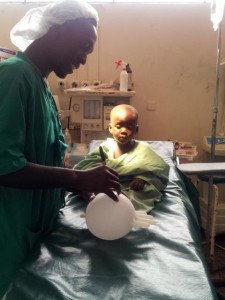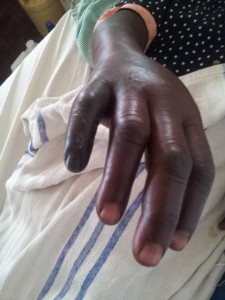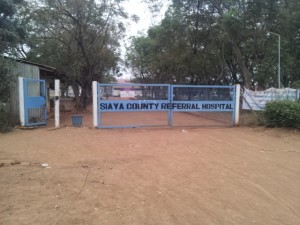I feel like I have been a bit of a jack-in-the-box since my last blog. Taking the advice of one of the doctors, I have been moving about the hospital following the action so to speak. This has included spending quite a lot of time on the General Medicine ward and Pediatric ward to give myself a wide range of exposure to different patients and presentations before my time is up. Again, I have seen so many cases for which all I can think for the first few minutes is ‘wow!’ I takes a moment to absorb it all before the questions start falling out of my mouth.
There are definite common presentations on the internal medicine ward, nearly all infectious in nature. Most prevalent would have to be severe malaria, followed by pneumonia, TB and meningitis. A large majority of patients are HIV positive. I have had them described to me as “human Petri dishes, able to grow almost anything”.
It wasn’t meant in a nasty way, it really is a very accurate description. For those of you who aren’t familiar with this term, Petri dishes are used in labs with a nutrient rich medium to grow bacteria. I have gained a huge appreciation for just how important our immune system is. Without it we are a very susceptible nutritious feeding ground for all the bacteria, viruses, parasites and other nasties in our environment.
Malaria is a remarkably vicious disease. Seeing its consequences is certainly motivation to remember my prophylactic antibiotic every morning. It can cause a huge number of different presentations. Commonly patients, of all ages, are brought to hospital in near comatose states with hypoglycaemia and haemoglobin levels so low, I almost wouldn’t have believed they were compatible with life.
Running a blood screen for malarial parasites is easy, cheap and standard for anyone presenting to the hospital with unspecific illness. Like HIV, the rates here are some of the highest in Kenya. The US Centre for Disease Control (CDC) have a dedicated research, education and treatment area in the hospital and often run eradication programs.
Treatment is relatively straightforward if caught early. However chronic malaria is a leading cause of premature death. One very sad case was a patient who died from florid heart failure secondary to chronic malaria. It had reduced her haemoglobin to a level where her heart had to work so hard to get enough oxygen to her body it eventually gave up at the age of just 24 years.
Getting blood transfusions for these patients is not easy either. They often require at least four bags but are considered low priority with children, the maternity ward and surgical patients preferentially given the limited supplies. It is not exactly a safe option either as anyone is able to donate blood under the current system. A patient’s transfusion status is an important part of the medical history. However, the blood does travel to Kisumu for screening for HIV and other disease before being returned to Siaya.
As I mentioned above, very sick and weak HIV patients make up the bulk of the medicine ward patients. It really is a huge problem here and the medical community is struggling to reduce the rates.
They are very susceptible to large skin infections and abscesses, TB, pneumonia and meningitis caused by organisms rarely capable of causing these illnesses in a normal person. They can present with any manner of unusual complications. We also have two HIV patients being nursed for fistulas. The first had a bowel obstruction. Some of his bowel died and it was resected out. Unfortunately the area where the bowel ends had been joined broke down and he has developed two fistulas one which is 10cm long between the gut and his abdominal wall. His faeces now discharge out through these communications.I have noticed the doctors walking speed increases as they approach this patient. It is a horrendously difficult case to manage. Surgery is asking for more trouble and the patient is so malnourished a surgeon is unlikely to risk touching him. The management is hygiene and nutrition in the hope they will spontaneously close.
How do you achieve that? Very good question. The patient is reluctant to eat because it passes straight out the large 10cm open fistula on his tummy, nor can he or the hospital provide the intensive management required to keep the wound clean and in a condition which will promote healing. The patient has been encouraged to buy a colostomy bag but he cannot afford to so the fistula is covered with gauze to catch the discharge.
The second patient was thought to have a fistula forming a communication between his rectum and surrounding skin. As he has been lying in hospital, it has become evident there is a large fungating anal cancer as well. Again HIV patients are much more susceptible to virus associated cancers, including anal cancers, Karposi’s sarcoma and cervical cancer in women.
I didn’t realize it at the time but I have also seen my very first case of tetanus, something I have only seen my pet lamb die of many years ago. A lady presented with neck spasms, body rigidity, difficulty breathing and decreased consciousness. It seems more obvious looking back now but at the time it wasn’t so. It was thought she had meningitis and was treated so. Due to the spasms no lumbar puncture could be performed. Unfortunately she died of respiratory failure due to paralysis of her breathing muscles before she could be referred to the Kisumu hospital for more intensive management.
Perhaps not so useful for practice in New Zealand, I have learnt how to manage snakebites. Here is fun fact for you, sucking out the venom is not the advised thing to do, no matter how many times you have seen it save a life in the movies. The picture of the hand is three days following a snakebite sustained while collecting wood. A series of very unfortunate circumstances, including arriving on a weekend, meant that this poor lady didn’t get any treatment for four days by which time her little finger had died and the necrotic tissues was spreading up her hand. Anti-venom is worth a lot per dose and sadly the hospital supply finds its way to the community market making it very difficult to get a hold of and constantly ‘out of stock’ when bite patients present.Pediatrics left me no less amazed. Again a lot of the presentations are the result of infectious causes, dysentery, pneumonia, malaria, TB, meningitis and cellulitis. What I enjoy about the pediatric population is that with appropriate management their wee bodies respond quickly. A child who looked ill and floppy one day can be up eating and smiling the next. On the other hand, they can also be very fragile.
One case we had was a 7-year old boy whose chicken pox, usually well managed by the child’s immune system, became complicated. He developed a severe lung infection and inflammation and was diagnosed during his admission as HIV positive. Watching him struggle to breath is a distressing sight and he has lost a significant amount of weight since he was admitted over a week prior. He is expending huge amounts of energy just to breath. He sometimes receives oxygen, sometimes not, and we have discovered he has nasal polyps meaning any oxygen he was receiving by nasal prongs was being obstructed too. One of the doctors is keen to have him referred to Kisumu for ventilation but no such management plan can be executed without the paediatrician’s go ahead. The paediatrician visits twice weekly for a ward round and the weekly outpatient clinic.
I met an American nurse on the ward who is helping to conduct a clinical trial in various locations in Africa. They are trialing the use of CPAP (continuous positive airway pressure) machines for children aged between 18months to 5 years with respiratory distress from conditions such as pneumonia. It is often used in pre-term babies who struggle to breath after birth due to immature lungs and adults with sleep apnoea. She said their results have been very positive with children’s rate of breathing decreasing by 15-20 breaths per minute after an hour or so of CPAP. That means a lot less energy expenditure and these children are less likely to die from fatigue. She has donated one CPAP machine to the ward and has been teaching the team how to properly fit and use it. It will be an interesting piece of research to look out for in the future.
Another common disease managed in the pediatric population here is sickle cell disease. The prevalence of sickle cell in this part of the world is close to 25% as it confers some resistance to malaria. While this may be a positive, it is a debilitating disorder. Children and young adults present with severe pain caused by the sickled cells blocking blood vessels and therefore blood supply to bone and internal organs resulting in small areas of tissue death. They can also be severely anemic and it is not uncommon to see children with distorted head shapes due to their skull bones being abnormally stimulated to produce red blood cells in an effort to maintain the oxygen levels in their blood.It is probably more fascinating seeing this in real life than reading about it in a blog but they are totally incredible sights to see. These are things I have seen in pictures and learnt about but would be very unlikely to see in the New Zealand setting.
This weekend I ventured to Kakamega Forest. Getting there was an adventure in itself as it required three different matatu rides. My booked ‘guest house’ accommodation turned out to be in one of the communities local bars and vigorous negotiation was required to obtain some coal for cooking after being assured, before arriving, gas was available. The stench from the squat toilet hidden by a curtain that was too short for its purposes meant sleeping with tissues up both nostrils in order for a few hours of sleep to be had. A definite ‘only in Africa’ experience.
However, the forest was beautiful. I got up early to watch the sun rise, a sight I don’t think I could get sick of. Predators in the forest are long gone due to previous unregulated hunting. It is now home to baboons, Columbus monkeys, butterflies, snakes and Africa’s most vicious cobras and numerous birds.The Kakamega area produces huge amounts of sugar cane which is transported by the tractor load down the narrow dusty roads. When the cane is ready, the crop is burnt to rid it of the leaves before harvest. The remaining stump is then left to grow again, so a very productive, easy care crop for the region. It is a popular snack for children and adults who I see frequently chewing and spitting out the cane fiber or running down the road trying to sell bags to passing cars. A dentist’s nightmare, I would imagine.





1 Comment to 'General Medicine and Paediatrics'
June 3, 2016
whoah this weblog is wonderful i love reading your articles.
Keep up the good work! You understand, a lot of persons
are hunting round for this info, you can aid them greatly.
Leave a comment